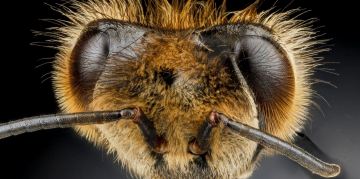
There’s a big brain behind those big eyes.
A bee brain is bigger in the summer, when there are more things to learn, experience, and think about. It shrinks in the winter, which must be a blessing because bees spend weeks on end doing nothing – an active brain might lead to boredom and depression if you are one of thirty thousand bees assigned the job called ‘cluster’ for six weeks. You and I know that the same bee who experiences the bliss of spring and summer is unlikely to be alive in mid-winter, so this would be an average. As such, it is possible that there is something fundamentally different about summer versus winter bees (like nutrition), but researchers think that the variation in brain size is due to the lack of meaningful thought during the winter months.
Researchers at Monash University (a huge campus of 65,000 students in Melbourne, Australia) found something else, too. Professor Charles Claudianos at the Monash Institute of Cognitive and Clinical Neurosciences thinks he and his colleagues have discovered part of the controls which influence bees’ aggression.
Beekeepers know that smoke and certain scents (like lavender) calm bees while other odours (human sweat, expensive cologne, whiskey breath, and perfume) agitate them. Using this knowledge, Claudianos studied bee brain chemistry and neurological function. According to a news release issued by Monash University, “the team has shown that odours such as lavender block aggressive behaviour not by masking the alarm pheromones, but by switching the response off in the brain.” This is different from what I thought. I figured that my smoker provided a camouflage odour that hid my own manly scent. Maybe not, says the research.
The resulting report (“Appetitive floral odours prevent aggression in honeybees“) was published in Nature. There is more work to do, of course, however, the entire field of examining bee brains and neurological function is an exciting and potentially mind-altering way to understand both honey bees and humans.
 Humans? The human application of bee brain discoveries is potentially huge. Bee genetics is relatively simple. Despite their intricate social behaviour, bees have fewer genes than most living creatures, even including plants. Working with a highly developed social insect which displays advanced community and language activity – but which possesses a limited number of genes – is a smart choice to analyze aggression, nurturing, and cooperation. Applicable human corollaries are being investigated, including the bees’ ability to learn, remember, and read The ABC & XYZ of Bee Culture, which seem similar to our own.
Humans? The human application of bee brain discoveries is potentially huge. Bee genetics is relatively simple. Despite their intricate social behaviour, bees have fewer genes than most living creatures, even including plants. Working with a highly developed social insect which displays advanced community and language activity – but which possesses a limited number of genes – is a smart choice to analyze aggression, nurturing, and cooperation. Applicable human corollaries are being investigated, including the bees’ ability to learn, remember, and read The ABC & XYZ of Bee Culture, which seem similar to our own.
It speaks volumes that Dr Claudianos, one of the authors of the bee brain research paper, is actually a brain scientist focused mainly on human neurology. His university biography tells us “his research topics include the molecular basis of learning and memory, human DNA variations associated with autism, RNA and epigenetic regulation of brain plasticity.” And now, bee brains.

The effect of linalool on aggression was most interesting and had me wondering about aromatherapy for bees – see: windsorhoney.blogspot.com/2016/02/aromatherapy-for-bees.html
Do you know if anyone has tried this?
LikeLike
Hi,
Glad you read the original Nature piece as there was a lot in there (including linalool) that I didn’t mention in my little summary. I do not know if aromatherapy for bees has been tried. The only caveat I can think of is that caution would need to be used so that no chemical mist settles on the hive equipment. Most jurisdictions tell us that we can’t put anything chemical into a hive that has not been approved. Please let us know if you look into this further.
LikeLike
Thanks Ron. So interesting! I retook my Bee Masters last week at UBC. There’s an incredible body of honey bee research underway. We were fortunate to hear from the likes of scientists Dr. Marta Guarna, Dr. Michelle Flenniken, Dr. Amro Zayed, and others who come to the table with varied and impressive backgrounds. Hopeful for apiculture and human medical challenges. Diane
LikeLike
LUCKY! That must have been an incredible course! We seem to be learning so much about bees these days. It’s like a new golden age of bees!
LikeLike
That is interesting about the lavender and makes me wonder how many other flowers would have that effect if we put them in our smokers.
LikeLike
Pingback: 2016 in Bee Review | Bad Beekeeping Blog